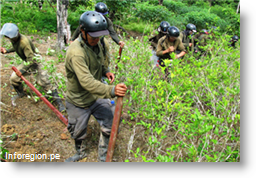 Peru’s government has surpassed its goal for the eradication of coca crops this year, according to the head of the country’s anti-drug agency, Carmen Masias.
Peru’s government has surpassed its goal for the eradication of coca crops this year, according to the head of the country’s anti-drug agency, Carmen Masias.
Masias told Canal N television that 22,300 hectares of coca have been eradicated in 2013, higher than the 14,000 hectares eradicated in 2012, and more than double the eradication goals of previous administrations.
The anti-drug agency, Devida, set its goal in January when it said it planned to increase the eradication of coca bushes to 22,000 hectares this year.
Coca leaves are the basis of cocaine. Although coca leaves are still used for traditional medicine and rituals, the larger share of crops are illegal and supply the drug trade. The United Nations reported this year that Peru officially overtook Colombia as the world’s biggest cocaine producer.
Peru’s government is doubling down on eradication as a key tool to combat the country’s thriving cocaine trade. The policy could face a backlash, however, if coca farmers are not assisted to seek alternative means of income. The Global Post cited in an October article upset coca farmers saying they could fight back against the government’s eradication program.
The government’s anti-drug policies also include the implementation of alternative development and crop substitution programs, increasing the military’s presence in remote coca growing regions, ensuring better controls of precursor chemicals to make cocaine, and tackling money laundering.
According to the state prosecutor Sonia Medina, drug trafficking moves some $2 billion a year in Peru.






Erradication may be a good bussines for the mafia; scarcity of the drug helps in pushing up drug price, making it a more profitable business. More business for the mafia, for the poor famer, and to the whole chain, Drug trafficking is the best way to learn how the economy works. Making cocaine less easily available increases its price; price increase makes it a more profitable business. It may make it more risky, and thus more profitable. For all, including the arms business : a big stake linked to the drug business!!
This story has been going up for three decades. It is un-understadable how the US, leading the market economny worldwide, when it comes to drugs they seem no to understand how to stop the business. Or is the current drug policy a part of the business? And certainly, one of the best ways to feed the arms industry (radical guerrillas may pay for a machine gun with drug money, great business for the manufacturers!)
Erradication: more money for the mafia, more money for the drug enforncement agencies -jobs and better paid, more money for the corportaion selling all sort of equipment to fight drug trafficking (from drug scanning systems to helicopters) , more money for mostly not very effective public health services that make money and increase jobs by offering treatments for drug addicts. Wow! Just need to think logically, not needed much on your brains…unless you have these affected by drugs (and among these, those sold in the pharmacies, the other side of the same coin….another big business)
Keep erradication, keep prohibition and as such , feed more and more the drug business, Or is it not what has been happening. So obvious!!!